As a healthcare professional, I aim to give people the knowledge to spot stroke warning signs early. Strokes can be very serious, but catching them early can really help. Quick action and medical help can make a big difference.
This guide will cover the main stroke symptoms. It will help you know what to do fast if you see these signs. Signs include sudden paralysis, trouble speaking, vision issues, and bad headaches. Knowing these signs can save lives.
Key Takeaways
- Stroke symptoms need quick medical help to lessen damage.
- Seeing facial drooping, arm weakness, and speech issues means a stroke might be happening.
- Other signs include vision problems, severe headaches, and losing balance.
- Acting fast, like calling 911, can boost survival and recovery chances.
- Knowing what raises stroke risk and how to prevent it can lower your chances of having a stroke.
Understanding the Urgency of Stroke
Strokes are serious emergencies that need quick action. Every minute is crucial for saving brain function and reducing damage. Knowing the signs of a stroke and acting fast can mean the difference between recovery and lasting harm.
The Significance of Rapid Response
When a stroke happens, the brain doesn’t get enough oxygen-rich blood. This can cause permanent damage to brain cells. Quick medical help is key to fixing blood flow and protecting brain health. Waiting too long can make things much worse and lead to permanent stroke prevention issues.
Stroke: A Medical Emergency
Treating a stroke as a major medical crisis is essential. Calling for emergency help right away is the first critical step. This way, experts can quickly start treatments that save lives. Waiting or trying to drive to the hospital can lose valuable time and lower the chance of a good outcome.
“Stroke is a medical emergency. Every second counts when someone is having a stroke. Fast action can lead to a better recovery.”
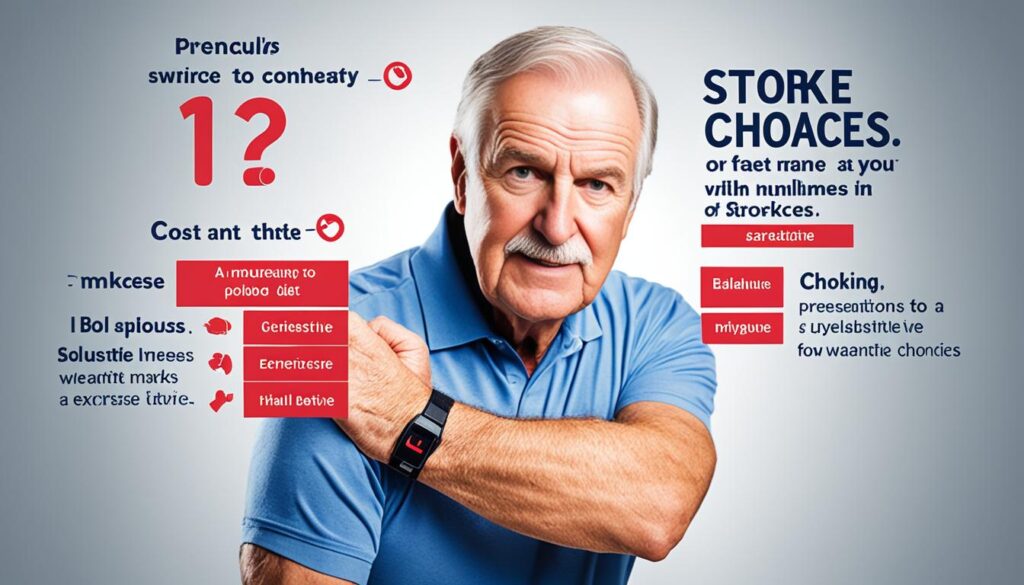
The urgency of stroke is clear. Spotting the signs and acting quickly are key to saving brain function and improving recovery chances. Knowing how urgent it is helps in stroke prevention and protecting brain health.
Recognizing the Warning Signs
Knowing the warning signs of a stroke is key to getting quick medical help. By spotting the symptoms, you can act fast to lessen the stroke’s severe effects.
Facial drooping is a clear sign of a stroke. It shows as sudden weakness or numbness on one side of the face. This makes it hard for the person to smile or look normal.
Arm weakness or numbness is another sign. If someone suddenly can’t feel or move one arm, it might be a stroke. Asking them to lift both arms can show if this is happening.
Difficulty speaking is also a warning. If someone’s speech is slurred or hard to understand, it could mean a stroke. Asking them to repeat a simple phrase can check if they can speak clearly.
| Stroke Symptom | Description |
|---|---|
| Facial Drooping | Sudden weakness or numbness on one side of the face, making it difficult to smile or maintain a normal expression. |
| Arm Weakness | Sudden loss of strength or feeling in one arm, making it difficult to raise the arm. |
| Speech Difficulties | Slurred, garbled, or incomprehensible speech, indicating a potential stroke. |
| Vision Problems | Sudden blurred or double vision, or a sudden, severe headache, which can be signs of a stroke. |
| Dizziness and Balance Issues | Sudden loss of balance, coordination, or vertigo, which can indicate a stroke. |
| Confusion and Memory Lapses | Sudden confusion, disorientation, or memory problems, which can be symptoms of a stroke. |
| Numbness or Tingling | Sudden numbness or tingling in the face, arm, or leg, which can be a sign of a stroke. |
Other signs include vision problems like blurred or double vision, a severe headache, dizziness and balance issues, confusion and memory lapses, and numbness or tingling in the face, arm, or leg.
If you or someone you know shows any of these sudden, severe symptoms, get medical help right away. Quick action can greatly improve the outcome and lower the risk of lasting harm or disability.
Facial Drooping: A Telltale Sign
Facial drooping is a key sign of a stroke, showing up as an uneven smile or a sagging eyelid. This unevenness and muscle weakness is a big clue that a stroke might be happening. It tells both the person and doctors to act fast.
Asymmetry and Muscle Weakness
A stroke can mess with the nerves that control muscles on one side of the face. This leads to a drooping or lopsided look. This drooping is a clear sign that something’s wrong and shouldn’t be ignored.
It also makes it hard to close the eye or smile evenly because of muscle weakness. Spotting these changes quickly is key. It helps tell a stroke apart from other health issues and guides doctors to the right treatment.
Quick action and getting to the hospital fast are crucial if you see facial drooping. This can greatly improve your chances of getting the care you need to save your life.
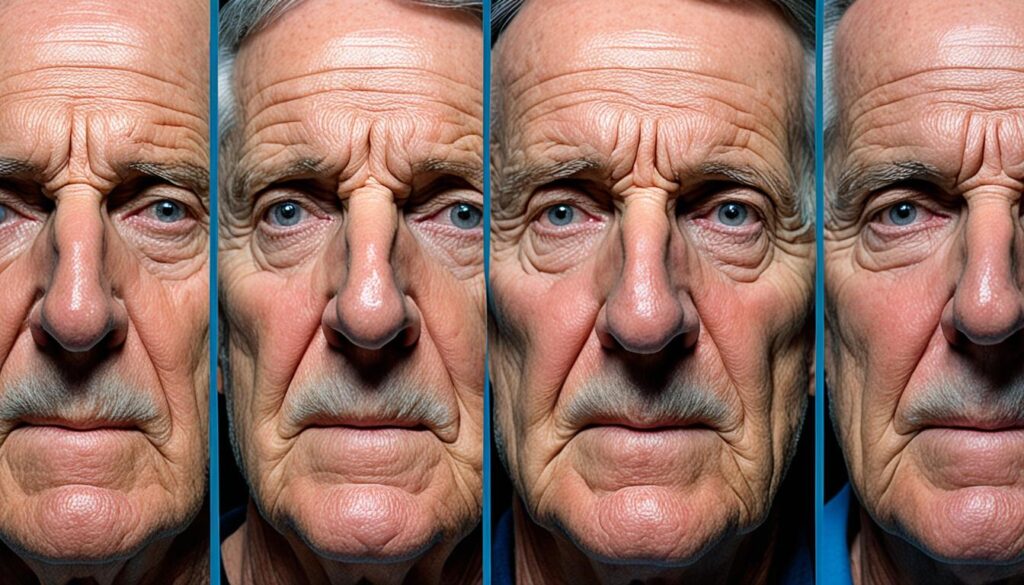
“Facial drooping is one of the most obvious and concerning signs of a stroke, as it indicates a disruption in the neural pathways controlling the muscles on one side of the face. Recognizing this asymmetry is a critical first step in getting the necessary medical care.”
Spotting and reporting facial drooping can really change the outcome. Knowing how important this sign is helps people react fast when a stroke happens. This can mean the difference between a good recovery and serious harm.
Arm Weakness and Numbness
Sudden weakness or numbness in the arm is a key stroke symptom. It often happens on one side of the body. Recognizing this sign quickly is very important.
Arm weakness or numbness can show up in different ways. The affected arm might feel heavy or hard to lift. Or, it could be completely paralyzed. Some people feel tingling or numbness, making it hard to hold objects or do simple tasks.
This symptom usually affects only one arm. If one arm is much weaker or less responsive than the other, it could mean a stroke is happening. This stroke affects the opposite side of the brain.
| Symptom | Explanation |
|---|---|
| Arm Weakness | Difficulty lifting or moving the arm, often on one side of the body. |
| Arm Numbness | Tingling or numb sensation in the arm, making it difficult to grip or manipulate objects. |
| Unilateral Presentation | Weakness or numbness affecting only one side of the body, indicating a potential stroke. |
If you or someone you know has sudden arm weakness or numbness, especially on one side, get medical help right away. Quick action can greatly improve the outcome and reduce the risk of paralysis.

“Recognizing the signs of a stroke, including arm weakness or numbness, can be the difference between life and death. Time is of the essence, so don’t hesitate to call for help if you suspect a stroke is occurring.”
Speech Difficulties: Slurred or Incomprehensible
Recognizing stroke signs is key, and speech issues are a big clue. Signs like slurred words or not making sense are key stroke symptoms. They mean you should act fast.
Aphasia is a common stroke symptom that affects how someone uses language. It can make it hard to find words, speak in short sentences, or even stop communicating altogether.
“Aphasia is a devastating condition that can profoundly impact a person’s ability to communicate, but early recognition and prompt medical intervention can make a significant difference in the recovery process.”
Other speech problems from a stroke include:
- Slurred or garbled speech
- Difficulty forming words or sentences
- Sudden inability to speak or understand spoken language
These issues happen when blood flow to the brain’s language areas is blocked. Quick action is vital. The sooner a stroke is treated, the better the recovery chances.

Knowing about speech symptoms and acting fast can help. It can lead to better treatment and a quicker recovery from a stroke.
Vision Disturbances: A Potential Indicator
Stroke can greatly affect our vision, leading to sudden changes. Common visual issues include blurred or double vision. These signs are key to spotting a medical emergency.
Sudden Blurred or Double Vision
Blurred vision or double vision (diplopia) can be an early stroke sign. It happens when the brain can’t process visual info right, often from a blockage or bleeding. People may struggle to focus, causing confusion and disorientation.
These vision issues can affect one or both eyes, starting suddenly or slowly. Any sudden vision changes are a medical emergency. They need immediate medical help.
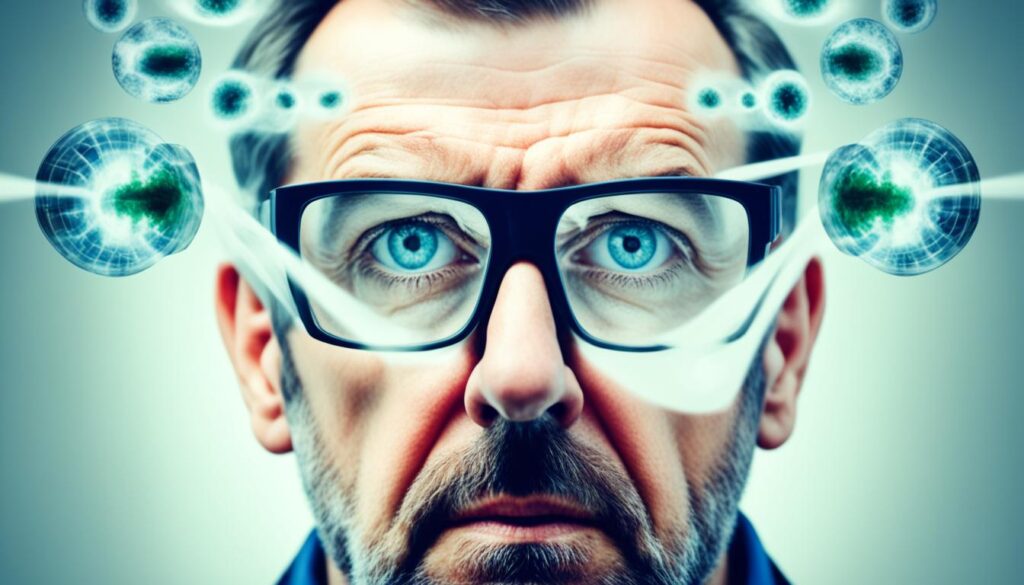
Quick action on vision problems linked to stroke is crucial. Early treatment can lessen vision and health damage. If you see sudden vision changes, call emergency services or get medical help right away.
Severe Headache: An Alarming Symptom
A severe, sudden headache is a key sign of a stroke. It’s often called the “worst headache of one’s life.” This intense pain can signal a stroke is happening.
Strokes can cause many symptoms, including a sudden, severe headache. This headache is unlike any other and can start without warning. It’s so bad, it can make it hard to do everyday tasks.
Not all headaches mean a stroke is happening. But, if a severe headache comes with other stroke signs like facial drooping, arm weakness, or speech difficulties, it’s an emergency. You should get help right away.
If you have a sudden, severe headache, especially with other stroke signs, call 9-1-1 or get to the hospital fast. Quick action can make a big difference in the outcome.

Knowing the signs of a stroke and acting fast can save lives. Being alert to signs like a severe, sudden headache helps ensure quick, lifesaving care.
Dizziness and Loss of Balance
Stroke can cause dizziness, loss of balance, and trouble with coordination. These symptoms are scary and important to notice as possible stroke signs.
Vertigo and Coordination Issues
Vertigo, feeling like you’re spinning, is a common stroke symptom. It makes it hard to stay balanced and move well. This increases the chance of falling and getting hurt.
Stroke also leads to coordination and balance problems. People may struggle to walk, stand, or do simple tasks that need fine motor skills.
- Sudden onset of dizziness or vertigo
- Difficulty maintaining balance or coordination
- Unsteadiness when walking or standing
These symptoms are scary and might mean you need to see a doctor right away. Knowing how dizziness, loss of balance, and stroke are linked is key. It helps get quick treatment and lowers the risk of serious problems later.

“Dizziness and loss of balance are serious stroke symptoms that require immediate medical attention. Recognizing these warning signs can make all the difference in timely treatment and recovery.”
Confusion and Memory Lapses
Stroke can greatly affect how we think, leading to confusion and memory problems. These issues might seem small at first but are important signs of a serious health issue.
Confusion is a big sign of a stroke. People may find it hard to understand information, follow simple directions, or know where they are. This makes it tough for them to make choices or talk clearly.
Memory problems are also a warning sign of a stroke. Patients might forget recent events, not recognize people they know, or have trouble remembering things for a short time. These changes can be scary for both the person and their family.
Confusion and memory issues aren’t just normal signs of getting older or being stressed. They could mean a serious health problem that needs quick help. Spotting and acting on these signs can really help with recovery.
| Symptom | Description |
|---|---|
| Confusion | Difficulty processing information, following instructions, or orienting oneself to surroundings. |
| Memory Lapses | Trouble recalling recent events, recognizing familiar faces or names, or maintaining short-term memory. |
If you or someone close to you suddenly feels confused or forgetful, get medical help right away. Spotting and acting on these stroke symptoms quickly can really change the outcome.

Numbness or Tingling Sensations
Feeling numbness or tingling on one side of your body could be a stroke warning sign. It’s important to notice these signs and get help fast. They might mean your brain isn’t getting enough blood.
Numbness or tingling in your face, arm, or leg on one side is a stroke symptom. This happens when a blood clot or a broken blood vessel cuts off oxygen-rich blood to part of your brain. Without enough blood, nerves and tissues don’t work right. This leads to losing sensation or feeling tingling and prickling.
If you suddenly feel numbness or tingling, especially on one side, act fast. Stroke is a medical emergency, and every second counts for treatment and recovery. Call emergency services or go to the hospital right away. This can greatly improve your chances of a good outcome.
Knowing the stroke warning signs, like numbness or tingling, can save lives. By acting quickly, you can help yourself or your loved ones from the serious effects of a stroke.
“Time is brain. The sooner you can get treatment, the better the outcome will be.”
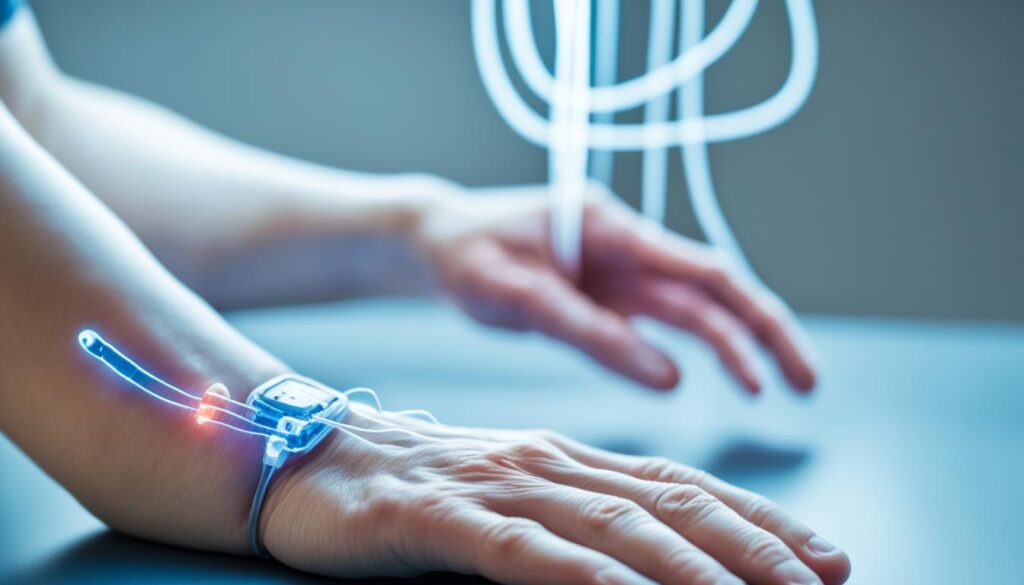
Seeking Immediate Medical Attention
If you or someone you know feels sudden, unexplained numbness or tingling on one side, call for help or go to the hospital fast. Quick medical help can greatly improve your chances and lessen the stroke’s effects.
By spotting the signs and acting quickly, you can boost your recovery chances. This helps protect your loved ones from the severe effects of a stroke.
Risk Factors and Prevention
Stroke is a serious condition that can have severe effects. But, many risk factors can be managed or prevented. By making lifestyle changes and getting medical help, you can lower your stroke risk.
Controlling High Blood Pressure
High blood pressure, or hypertension, is a big risk factor for stroke. Keeping your blood pressure in check is key to preventing strokes. You can do this by eating well, exercising regularly, and managing stress. Sometimes, you might also need to take medicine.
Managing Cholesterol Levels
High cholesterol, especially high LDL or “bad” cholesterol, raises your stroke risk. You can lower your stroke risk by eating right, staying active, and taking cholesterol medicine if you need it.
| Risk Factor | Preventive Measures |
|---|---|
| High Blood Pressure |
|
| High Cholesterol |
|
By tackling these risk factors and making lifestyle changes, you can lower your stroke risk. Early action and prevention are key to avoiding stroke’s serious effects.
Lifestyle Modifications for Stroke Prevention
Living a healthy life can greatly lower the chance of having a stroke. By choosing wisely in our daily habits, we can help prevent strokes. Let’s look at two main areas: eating right and exercising regularly.
Adopting a Healthy Diet
Eating a balanced diet is key to preventing strokes. Here are some tips to follow:
- Eat more fruits and veggies for antioxidants and fiber.
- Choose whole grains to keep your blood sugar stable.
- Go for lean proteins like fish, poultry, and beans for heart health.
- Reduce saturated and trans fats to avoid artery blockages.
- Drink lots of water to stay hydrated.
Incorporating Regular Exercise
Exercise is vital for stroke prevention. Try to do at least 150 minutes of moderate exercise or 75 minutes of hard exercise each week. Here are some fun ways to stay active:
- Brisk walking or jogging
- Swimming or water aerobics
- Cycling, either on the road or on a stationary bike
- Strength training with your own body or resistance bands
- Yoga or Tai Chi for heart health and flexibility
It’s important to pick activities you like and can do every day. Being consistent is the secret to seeing the benefits of a healthy lifestyle.
“Healthy habits, not hard rules, lead to long-term change.” – Dr. John Berardi, co-founder of Precision Nutrition
By eating well and exercising often, you can lower your stroke risk and keep your heart healthy. Small, steady changes can make a big difference in your health.
Psychological Well-being and Stroke Risk
When we talk about preventing strokes, we must look at how our mental health affects our brain. Stress and anxiety can raise our risk of having a stroke. By managing stress and practicing mindfulness, we can protect our heart and brain health. This also helps us think better and feel better overall.
Stress Reduction and Mindfulness Practices
Long-term stress can make us more likely to have a stroke. It can lead to high blood pressure and heart disease. So, it’s key to use stress management to lower our stroke risk and keep our brain and heart healthy.
- Regular exercise helps reduce stress and boosts memory enhancement.
- Mindfulness like meditation and deep breathing helps us stay calm and lowers stress reduction.
- Talking to friends, family, or a mental health expert can help with anxiety and depression, which affects stroke risk.
“Mindfulness is not just about stress reduction, but about enhancing overall brain health and cognitive function.”
Looking after our mental health helps us lower our stroke risk. It keeps our brain and thinking skills sharp for life.
Conclusion
In this guide, we’ve looked at stroke symptoms, the need for quick action, and ways to prevent strokes. By knowing the signs and taking steps ahead of time, you can protect your brain health. This can lower your chance of having a stroke. Being informed and acting fast can really change things.
This article stressed how important it is to spot stroke symptoms like facial drooping and speech problems. Getting to the hospital quickly is key because stroke is a serious emergency. It needs fast treatment.
We also talked about simple changes you can make to lower your stroke risk. These include controlling blood pressure, keeping cholesterol in check, eating right, and exercising regularly. Taking care of your mental health through stress reduction and mindfulness is also crucial. These steps can help you lower your stroke risk and protect your brain health.

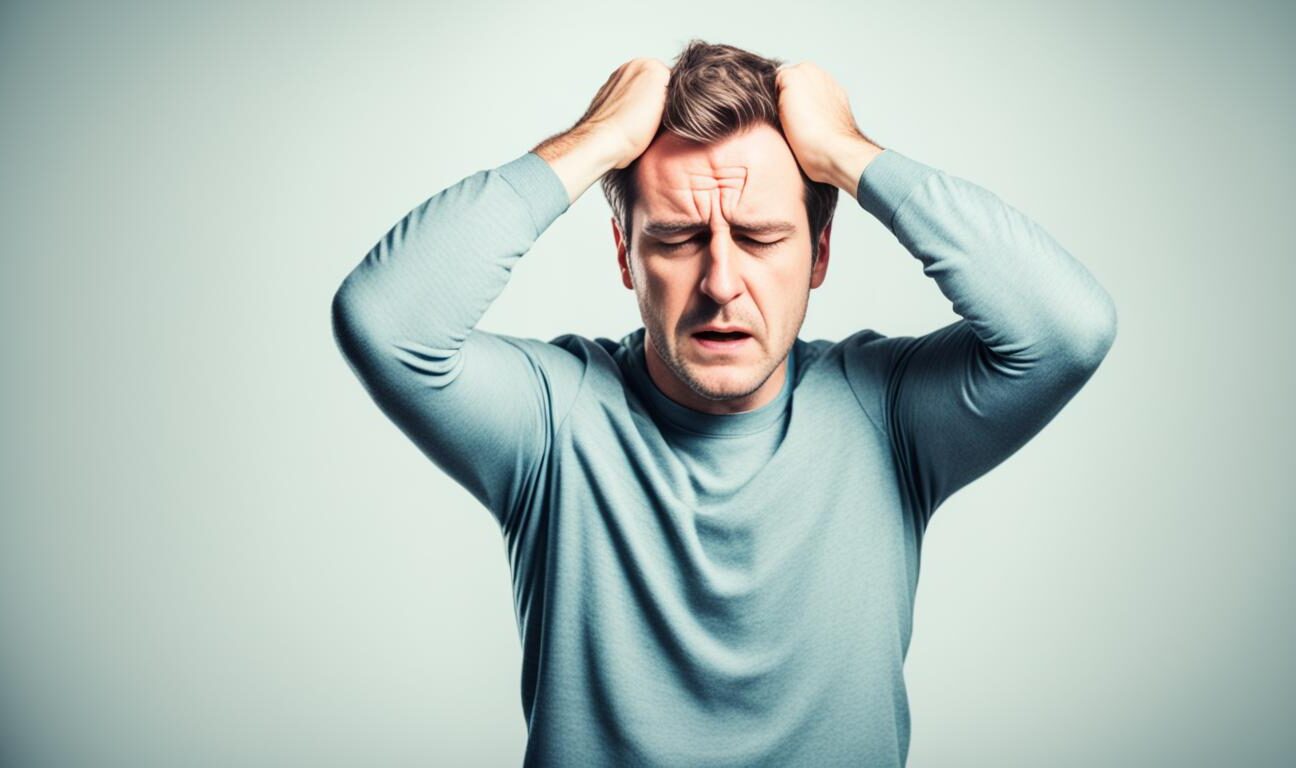

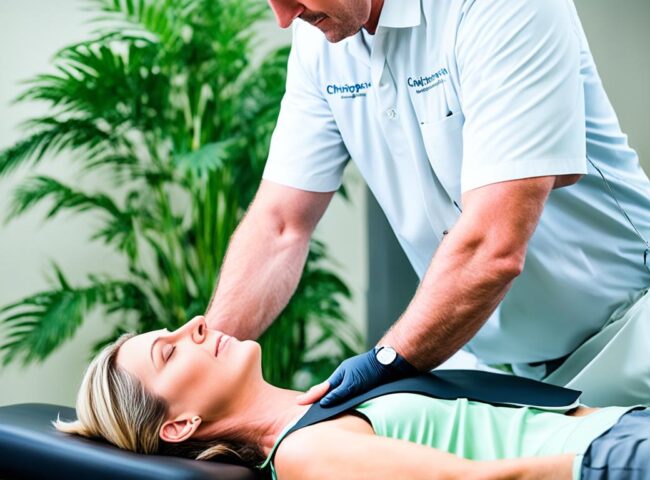


Leave feedback about this